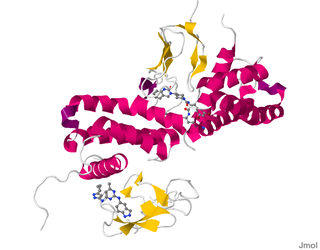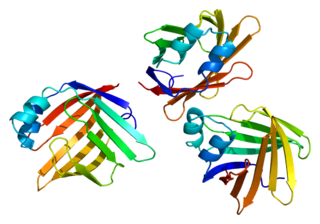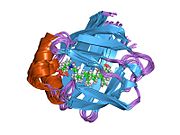
Thromboxane A synthase 1 , also known as TBXAS1, is a cytochrome P450 enzyme that, in humans, is encoded by the TBXAS1 gene.

aP2 is a carrier protein for fatty acids that is primarily expressed in adipocytes and macrophages. aP2 is also called fatty acid binding protein 4 (FABP4). Blocking this protein either through genetic engineering or drugs has the possibility of treating heart disease and the metabolic syndrome.

Bile salt-dependent lipase, also known as carboxyl ester lipase is an enzyme produced by the adult pancreas and aids in the digestion of fats. Bile salt-stimulated lipase is an equivalent enzyme found within breast milk. BSDL has been found in the pancreatic secretions of all species in which it has been looked for. BSSL, originally discovered in the milk of humans and various other primates, has since been found in the milk of many animals including dogs, cats, rats, and rabbits.

The G protein-coupled bile acid receptor 1 (GPBAR1) also known G-protein coupled receptor 19 (GPCR19), membrane-type receptor for bile acids (M-BAR) or TGR5 as is a protein that in humans is encoded by the GPBAR1 gene.

Fatty acid-binding protein 2 (FABP2) also known as Intestinal-type fatty acid-binding protein (I-FABP) is a protein that in humans is encoded by the FABP2 gene.

Calcitonin receptor-like (CALCRL), also known as the calcitonin receptor-like receptor (CRLR), is a human protein; it is a receptor for calcitonin gene-related peptide.

Non-specific lipid-transfer protein also known as sterol carrier protein 2 (SCP-2) or propanoyl-CoA C-acyltransferase is a protein that in humans is encoded by the SCP2 gene.

Insulin-like growth factor-binding protein 6 (IGFBP-6) is a protein that in humans is encoded by the IGFBP6 gene.

Putative G-protein coupled receptor 42 is a protein that in humans is encoded by the GPR42P gene.

Lysophosphatidic acid receptor 3 also known as LPA3 is a protein that in humans is encoded by the LPAR3 gene. LPA3 is a G protein-coupled receptor that binds the lipid signaling molecule lysophosphatidic acid (LPA).

Insulin-like growth factor-binding protein 1 (IBP-1) also known as placental protein 12 (PP12) is a protein that in humans is encoded by the IGFBP1 gene.

Retinol binding protein 1, cellular, also known as RBP1, is a protein that in humans is encoded by the RBP1 gene.

FABP1 is a human gene coding for the protein product FABP1. It is also frequently known as liver-type fatty acid-binding protein (LFABP).

Fatty acid binding protein 7, brain, is a human gene.

The RPS2 gene is the gene which, in humans, encodes the 40S ribosomal protein S2.

Choline-phosphate cytidylyltransferase A is an enzyme that in humans is encoded by the PCYT1A gene.

Myelin P2 protein is a protein that in humans is encoded by the PMP2 gene. Myelin protein P2 is a constituent of peripheral nervous system (PNS) myelin, also present in small amounts in central nervous system (CNS) myelin. As a structural protein, P2 is thought to stabilize the myelin membranes, and may play a role in lipid transport in Schwann cells. Structurally, P2 belongs to the family of cytoplasmic fatty acid-binding proteins (FABPs).

Zinc transporter ZIP6 is a protein that in humans is encoded by the SLC39A6 gene.

Bile acyl-CoA synthetase is an enzyme that in humans is encoded by the SLC27A5 gene.

Odorant-binding protein 2a is a protein that in humans is encoded by the OBP2A gene.


























